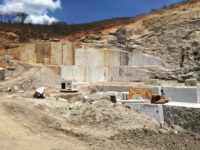Recently, Tales Machado, president of Centrorochas for the past year and a half, took time to discuss how the pandemic has affected the stone industry for Brazilian stone producers. From dealing with supply issues to shipping challenges, Tales explained to Stone World how Brazil has pressed through and built its economy back up.
TM: In May of 2020 is when the pandemic really started for Brazil, so it has been very difficult since that time. When I started here, sales went down a lot. We had a huge decrease in exportation of stone -- not just with natural stone but business for the whole country went down. We had a lot of doubts. We were not sure what the future would hold and what the outcome would be.
The second half of 2020, we had some improvement in sales and the market. The expectation was much higher than before. We were getting back to our pace in exports. By the beginning of 2021, we were still in the pandemic but we were learning to work through it. But I think the market adapted really well to this whole change. Even though in 2021 we had record sales and exports, we had many problems with logistics and other challenges.
SW: In the U.S., you hear a great deal about container shortages and port challenges. Were these things you dealt with in Brazil, as well as exporting products to the U.S.?
TM: We also had container shortage problems, as well as port congestions. We had a lack of ships, and more containers to go onto the ships than there were ships. It slowed down during 2020, but during 2021, people who didn’t buy in 2020 started to buy everything back in 2021 -- trying to get their inventory up. So we had a lot to export, but just didn’t have the ships to do it.
While all of Brazil had these problems, the natural stone sector seemed to really have these problems. We also had an increase on the prices of freight. We used to pay $2,000 to $2,500 for freight, and when we got back going and our market started to heat up again, we were paying $12,000 in freight. When we got back on track, we started facing logistic problems, as well as freight prices. Due to the freight prices, we had a problem with our products being competitive. As we had to pay more freight, we had to change the price on the product.
SW: Is the shipping and container issue still a problem or is it getting better?
TM: The supply of ships and containers still hasn’t gone back to normal. We are still having some problems -- especially in regards to the prices. In the U.S., you are dealing with seven or eight percent inflation. In Brazil, we are dealing with 10 percent inflation. The American companies are dealing with it as well because through the pandemic we have had new costs. That is also something we have to negotiate and work on. When we make these adjustments, this is something we have to negotiate with our clients because they may have agreed on a previous price. Even through all of this, the expectation for this year is very positive.







